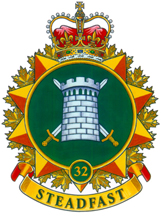| Site | Date(s) | Designated | Location | Description | Image |
|---|
Brampton Armoury
2 and 12 Chapel Street | 1914–15 | 1991 Recognized – Register of the Government of Canada Heritage Buildings | Brampton, Ontario | Housing B Company, The Lorne Scots, this centrally located, mid-size, rectangular building has a low-pitched gable roof. | |
Denison Armoury
1 Yukon Lane | 2003 | Canada's Register of Historic Places | Toronto, Ontario | Large centrally located building with a low-pitched gable roof houses 32 Canadian Brigade Group Headquarters; The Governor General's Horse Guards; 2 Intelligence Company; 32 Combat Engineer Regiment; 32 Service Battalion; 32 Military Police Platoon; 2 Area Support Group Signal Squadron C Troop; ASU Toronto. |  |
Fort York Armoury
660 Fleet Street | 1933–35 | 1991 Federal Heritage building; on the Register of the Government of Canada Heritage Buildings | Toronto, Ontario | Designed by architects Marani, Lawson and Morris in an industrial area of Toronto; this large, two-storey, drill hall with a concrete, vaulted roof is home to The Royal Regiment of Canada, Queen's York Rangers (1st American Regiment), 32 Signal Regiment and 32 Canadian Brigade Group Battle School. |  |
Captain Bellenden Seymour Hutcheson VC Armoury
70 Birmingham Street | 2009 | | Toronto, Ontario | The Captain Bellenden Seymour Hutcheson VC Armoury is a shared facility with the Toronto Police Service. The Armoury is considered a "Green Building" in accordance with the Leadership in Energy and Environmental Design (LEEDS) Green Building Rating System. This armoury is home to The Toronto Scottish Regiment (Queen Elizabeth The Queen Mother's Own). | |
Lieutenant-Colonel Samuel Beckett Armoury
7535 – 9th Line | 12 May 2012 | | Mississauga, Ontario | The Lieutenant-Colonel Samuel Beckett Armoury is a shared facility with the Mississauga Fire Department (Garry W. Morden Centre), Peel Regional Police Services and the Department of National Defence. The armoury is considered a "Green Building" in accordance with the Leadership in Energy and Environmental Design (LEEDS) Green Building Rating System. This armoury is home to The Toronto Scottish Regiment (Queen Elizabeth The Queen Mother's Own) 75th Mississauga Company. | |
Moss Park Armoury
130 Queen Street East | 1965 | Canada's Register of Historic Places | Toronto, Ontario | Housing 7th Toronto Regiment, RCA, The Queen's Own Rifles of Canada, 48th Highlanders of Canada, 25 Field Ambulance, this large centrally located building has a low-pitched gable roof. |  |
| Oakville Armoury | 1924 | Canada's Register of Historic Places | Oakville, Ontario | 1924 A centrally located building with a low-pitched gable roof; home of A Company, The Lorne Scots (Peel, Dufferin and Halton Regiment). | |
Col J.R. Barber Armoury
91 Todd Road | 1997 | Canada's Register of Historic Places | Georgetown, Ontario | Centrally located structure with a low-pitched gable roof houses C Company, The Lorne Scots. | |
| Dalton Armoury | 2006 | | Toronto, Ontario | Home of Buffs Company, The Queen's Own Rifles of Canada. | |
Lake Street Armoury
81 Lake Street | 1905 | Canada's Register of Historic Places | St. Catharines, Ontario | Home of A Company, Lincoln and Welland Regiment and 10th Battery, 56th Field Artillery Regiment, RCA | |






